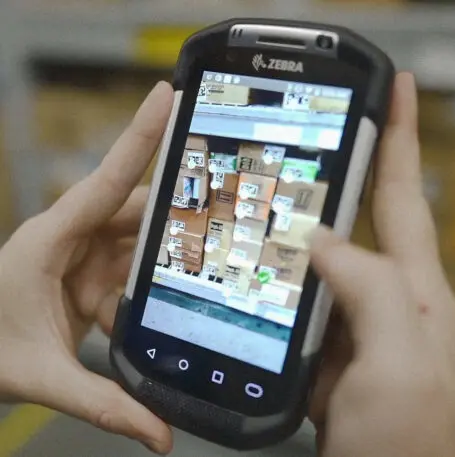A Walmart Supercenter stocks 120,000 different items on its shelves. But go to the store on a Saturday or Sunday—or arrange a curbside pickup—and you’ll learn that some things are missing from store shelves, so you can’t buy them. Walmart might still have the items at that location. It has 15,000 boxes of products stored in the back room of any given Walmart. But customers often grab items off the shelves before they can be restocked from the back.
Today, Walmart is taking a big step to fix this issue with a new augmented reality app built for its employees. It allows an employee in the back room to aim a phone at a wall of inventory, and the app will put a green checkmark next to the exact box they’re searching for.

How it fits into the existing ecosystem
This app sits on top of Walmart’s existing inventory tracking system. When a Walmart employee spots a missing item on shelves, or when enough of an item is scanned at checkout, software automatically signals employees in the back room with a list of items to grab and restock.
But while employees may know items that are out of stock, they still have to hunt down the one exact box that holds them. It’s a (cardboard) needle in a haystack.
Walmart’s new augmented reality app fixes this issue. Instead of consulting a list, and finding a box to match, employees are given the simple task of aiming their phone at a shelf. And the phone does all the work from there.
[Image: courtesy Walmart]
AR minus the razzle-dazzle
Thus far, AR has been more about dazzling the public than solving real business problems. The startup Magic Leap raised $3 billion to build what so far is little more than some fun mini games. And the headsets needed to be immersed in AR cost thousands of dollars.
Compared to special AR glasses that render 3D holograms, like Microsoft’s Hololens, Walmart’s solution is barebones. It runs on an inexpensive smartphone. The graphics are pared back. Walmart isn’t making a magical bird fly in into anyone’s hand. Instead, it’s marking the box employees need in that moment with a green checkmark, nothing more, nothing less.
The core technology behind the experience itself is pretty basic, too. The app isn’t analyzing box geometry or position on the shelf in any special way. It’s actually just reading a new style of tag that Walmart is placing on all its boxes, which looks something like a QR code. And the app is able to read dozens of these codes at once to find just the boxes that are needed.
Walmart insists the update is simply to improve available inventory for customers, and is in no way an efficiency designed to reduce employee head counts—after all, you still need people to take items from the stockroom to store shelves. The app is launching at 3,500 stores this week, and will expand to all Walmart locations by the end of the year.
And while you and I will never see this interface when shopping at Walmart, the app offers a case study in what augmented reality UX can do—no razzle-dazzle required.
Recognize your brand’s excellence by applying to this year’s Brands That Matter Awards before the early-rate deadline, May 3.